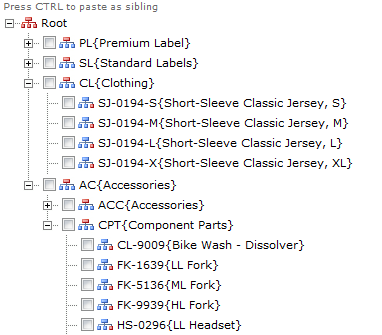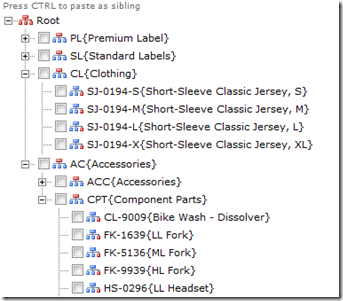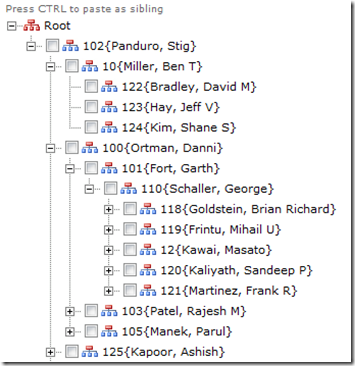Derived Hierarchies in Master Data Services are hierarchies created from the domain-based attribute relationships between entities, as explained in the following documentation, resulting in a fixed-depth hierarchy. A less obvious feature is that they can also be recursive, which by its very nature implies a ragged, variable-depth hierarchy. This is a characteristic that’s shared by Explicit Hierarchies, so it got me thinking that it would be worth a blog post to contrast Explicit Hierarchies and Recursive Hierarchies.
Explicit Hierarchies
Explicit Hierarchies use Consolidated Members to group other Consolidated and Leaf Members in order to make a hierarchy. The structure can be completely ragged, with each Consolidated Member having an unlimited number of Leaf or Consolidated Members beneath it.
An example of using Explicit Hierarchies is in the sample Product model that comes with MDS, which has an Explicit Hierarchy called Product Management. This groups members as shown in the (slightly edited) image below:
Note that the hierarchy is ragged, and that the Consolidated Members (PL, SL, CL, AC, ACC and CPT) can all have different attributes to the leaf members.
Recursive Hierarchies
Recursive Hierarchies allow an Entity Member to contain an attribute that points to another Member within the same Entity. Essentially this is a classical parent-child structure, which can of course also be ragged.
An example of using recursive hierarchies is in the Employee_Hierarchies sample model which can be downloaded from here. The image below shows one of the recursive hierarchies in the model, for employee managers:
Comparison
So, as we can see, both can be ragged and have a variable depth, so which one should we use? The following key points may help decide:
- Explicit Hierarchies must use Consolidated Members for the grouping. So a Leaf Member can’t suddenly become a parent. E.g. in an employee manager type hierarchy, where it would be common for an employee to become a manager once they have the relevant experience, with Explicit Hierarchies it would involve converting the Leaf Member to a Consolidated Member, which would be a pain.
- Its slightly easier to work with Recursive Hierarchies as you don’t need to worry about Consolidated Members. It can be a bit awkward to continually switch between Leaf and Consolidated Members in the explorer grid, so good to avoid it if possible.
- It’s not possible to set individual member permissions on a Recursive Hierarchy, whereas it is with an Explicit Hierarchy.
- Explicit Hierarchies can be added to Collections for more flexibility, whereas Recursive Hierarchies cannot.
- You won’t be able to have multiple hierarchies by using a Recursive Hierarchy (unless you go down the root of having multiple self-pointing attributes), whereas you can create multiple Explicit Hierarchies quite easily.
Considering all the above points, in my opinion anyway, a Recursive Hierarchy is more suitable when you have a genuine parent child requirement, e.g. for an employee hierarchy, or a chart of accounts. This is just down to the ease of use. An Explicit Hierarchy is more suitable when you just want to create groupings for your leaf members, but have the requirement to potentially have multiple ragged reporting hierarchies.




Introduction to Data Wrangler in Microsoft Fabric
What is Data Wrangler? A key selling point of Microsoft Fabric is the Data Science
Jul
Autogen Power BI Model in Tabular Editor
In the realm of business intelligence, Power BI has emerged as a powerful tool for
Jul
Microsoft Healthcare Accelerator for Fabric
Microsoft released the Healthcare Data Solutions in Microsoft Fabric in Q1 2024. It was introduced
Jul
Unlock the Power of Colour: Make Your Power BI Reports Pop
Colour is a powerful visual tool that can enhance the appeal and readability of your
Jul
Python vs. PySpark: Navigating Data Analytics in Databricks – Part 2
Part 2: Exploring Advanced Functionalities in Databricks Welcome back to our Databricks journey! In this
May
GPT-4 with Vision vs Custom Vision in Anomaly Detection
Businesses today are generating data at an unprecedented rate. Automated processing of data is essential
May
Exploring DALL·E Capabilities
What is DALL·E? DALL·E is text-to-image generation system developed by OpenAI using deep learning methodologies.
May
Using Copilot Studio to Develop a HR Policy Bot
The next addition to Microsoft’s generative AI and large language model tools is Microsoft Copilot
Apr